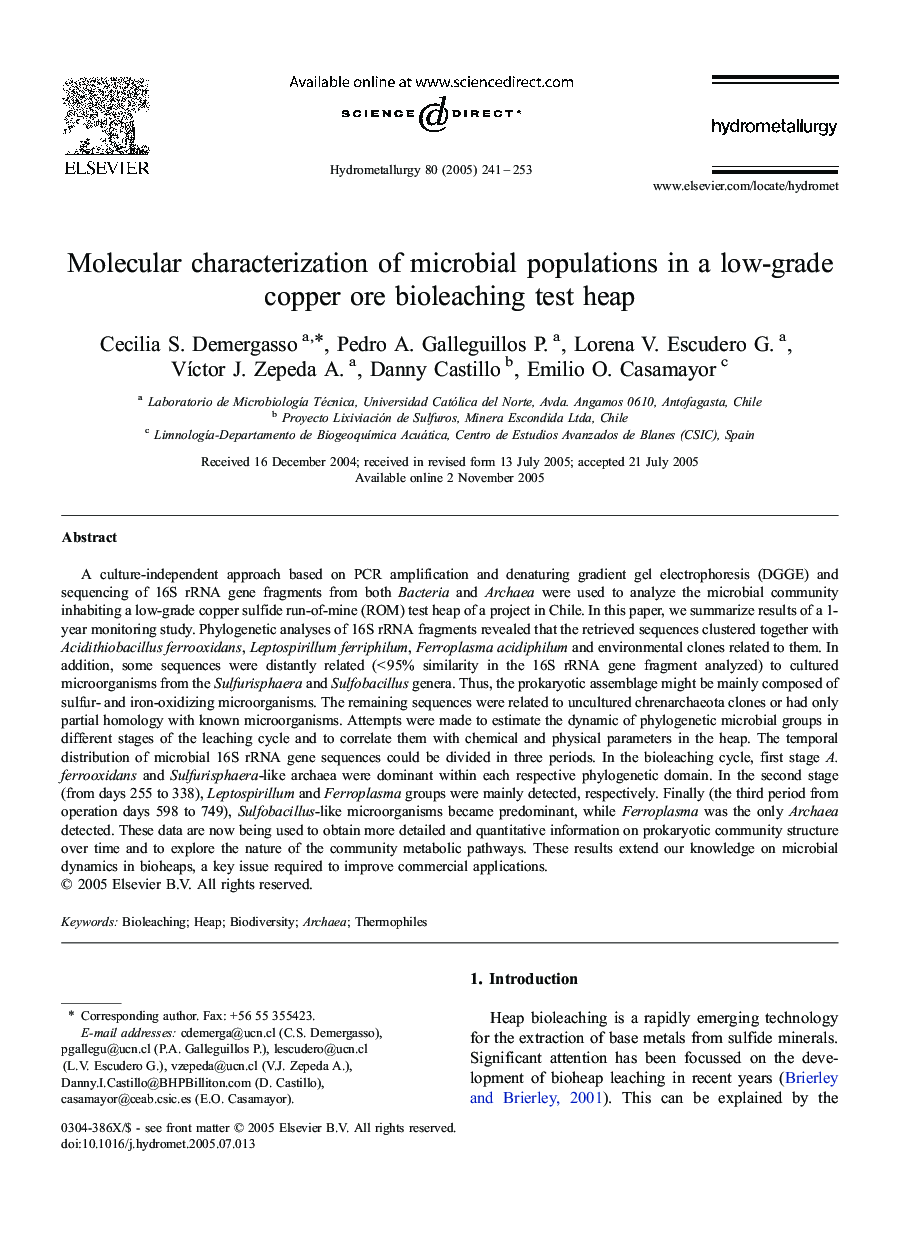| کد مقاله | کد نشریه | سال انتشار | مقاله انگلیسی | نسخه تمام متن |
|---|---|---|---|---|
| 9632485 | 462112 | 2005 | 13 صفحه PDF | دانلود رایگان |
عنوان انگلیسی مقاله ISI
Molecular characterization of microbial populations in a low-grade copper ore bioleaching test heap
دانلود مقاله + سفارش ترجمه
دانلود مقاله ISI انگلیسی
رایگان برای ایرانیان
کلمات کلیدی
موضوعات مرتبط
مهندسی و علوم پایه
مهندسی شیمی
مهندسی شیمی (عمومی)
پیش نمایش صفحه اول مقاله

چکیده انگلیسی
A culture-independent approach based on PCR amplification and denaturing gradient gel electrophoresis (DGGE) and sequencing of 16S rRNA gene fragments from both Bacteria and Archaea were used to analyze the microbial community inhabiting a low-grade copper sulfide run-of-mine (ROM) test heap of a project in Chile. In this paper, we summarize results of a 1-year monitoring study. Phylogenetic analyses of 16S rRNA fragments revealed that the retrieved sequences clustered together with Acidithiobacillus ferrooxidans, Leptospirillum ferriphilum, Ferroplasma acidiphilum and environmental clones related to them. In addition, some sequences were distantly related (<Â 95% similarity in the 16S rRNA gene fragment analyzed) to cultured microorganisms from the Sulfurisphaera and Sulfobacillus genera. Thus, the prokaryotic assemblage might be mainly composed of sulfur- and iron-oxidizing microorganisms. The remaining sequences were related to uncultured chrenarchaeota clones or had only partial homology with known microorganisms. Attempts were made to estimate the dynamic of phylogenetic microbial groups in different stages of the leaching cycle and to correlate them with chemical and physical parameters in the heap. The temporal distribution of microbial 16S rRNA gene sequences could be divided in three periods. In the bioleaching cycle, first stage A. ferrooxidans and Sulfurisphaera-like archaea were dominant within each respective phylogenetic domain. In the second stage (from days 255 to 338), Leptospirillum and Ferroplasma groups were mainly detected, respectively. Finally (the third period from operation days 598 to 749), Sulfobacillus-like microorganisms became predominant, while Ferroplasma was the only Archaea detected. These data are now being used to obtain more detailed and quantitative information on prokaryotic community structure over time and to explore the nature of the community metabolic pathways. These results extend our knowledge on microbial dynamics in bioheaps, a key issue required to improve commercial applications.
ناشر
Database: Elsevier - ScienceDirect (ساینس دایرکت)
Journal: Hydrometallurgy - Volume 80, Issue 4, 30 December 2005, Pages 241-253
Journal: Hydrometallurgy - Volume 80, Issue 4, 30 December 2005, Pages 241-253
نویسندگان
Cecilia S. Demergasso, Pedro A. Galleguillos P., Lorena V. Escudero G., VÃctor J. Zepeda A., Danny Castillo, Emilio O. Casamayor,